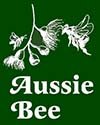MORE INFORMATION ON BLUE BANDED BEES (Amegilla)
Aussie Bee > Blue Banded Bee Information
NEW! The Aussie Bee Guide to
|
See Photos of Blue Banded Bees
See Videos of Blue Banded Bees
Blue Banded Bees are amongst our most beautiful Australian native bees. They are about 11 mm long and have bands of metallic blue fur across their black abdomens.
Blue Banded Bees are solitary bees. This means that each female bee mates and then builds a solitary nest by herself. She builds her nest in a shallow burrow in clay soil or sometimes in mudbricks. Many Blue Banded Bees may build their nest burrows in the same spot, close to one another, like neighbouring houses in a village.
Blue Banded Bees can perform a special type of pollination called 'buzz pollination'. Some flowers hide their pollen inside tiny capsules. A Blue Banded Bee can grasp a flower of this type and shiver her flight muscles, causing the pollen to shoot out of the capsule. She can then collect the pollen for her nest and carry it from flower to flower, pollinating the flowers. Quite a few of our native Australian flowers require buzz pollination eg Hibbertia, Senna.
Tomato flowers are also pollinated better when visited by a buzz pollinating bee. Researchers at the University of Adelaide made substantial progress in developing native Blue Banded Bees for greenhouse tomato pollination.

Above: a Bluebanded Bee buzz-pollinating a tomato flower inside a greenhouse.
It would be much better for our environment to use our native Blue Banded Bees for this purpose rather than introducing European Bumblebees to Australia!
Here a full list of the other information on Blue Banded Bees found on the Aussie Bee website:
Where are Blue Banded Bees found in Australia?
Blue Banded Bee nests and life cycle.
Blue Banded Bee nests.
Use as Greenhouse Tomato Pollinators.
Potential Pollinators of Greenhouse Tomatoes.
(Aussie Bee Online - Article 2)
Nests Viewed in Spectacular 3D!
(Aussie Bee Online - Article 7)
Make Nest Blocks for your Blue Banded Bees!
(Aussie Bee Online - Article 8)
More on Greenhouse Tomato Pollination.
(Aussie Bee Online - Article 9)
Adelaide Uni Pollination Trials.
(Aussie Bee Online - Article 10)
Blue Banded Bee photos - collection 1.
Blue Banded Bee photos - collection 2.
Blue Banded Bee photos - collection 3.
Blue Banded Bee photos - collection 4.
Blue Banded Bee video 1.
Blue Banded Bee video 2.
Blue Banded Bee video 3.
Blue Banded Bee video 4.
Blue Banded Bee video 5.
Other native bee videos.




